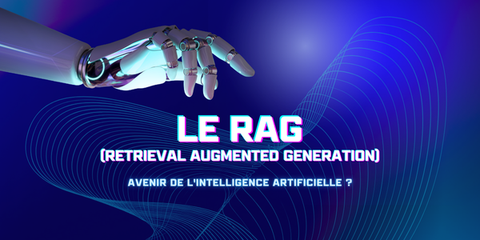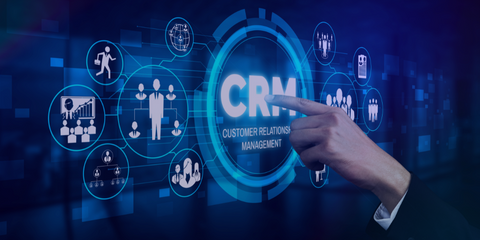Generative AI enables the creation of new and original content, such as text, images, music, and more. Within generative AI, Large Language Models (LLMs) specialize in understanding and generating natural language at scale. Trained on massive text corpora to grasp the nuances of human language, they are capable of producing high-quality outputs.
Retrieval-Augmented Generation (RAG), a more recent development, represents a major breakthrough in this field.
This innovative approach combines the strengths of information retrieval and content generation. Traditionally, LLMs generate content based solely on the data they were exposed to during their training phase. RAG, however, allows the model to actively “query” an external database or document corpus in real time to enrich its generated content. This retrieval capability significantly enhances the accuracy, relevance, and depth of the generated responses.
The RAG process involves two main steps:
- Retrieval—when the model receives a query, it searches a predefined set of documents or data to find the most relevant information.
- Generation—once the relevant information is retrieved, the model uses it alongside its internal knowledge to generate a response or content that is better informed and more precise.
 https://www.tonic.ai/blog/what-is-retrieval-augmented-generation-the-benefits-of-implementing-rag-in-using-llms
https://www.tonic.ai/blog/what-is-retrieval-augmented-generation-the-benefits-of-implementing-rag-in-using-llms
At the enterprise level, this new method of generating information and content could revolutionize both business efficiency and team productivity.
It enables organizations to combine proprietary datasets with internal company sources, leading to highly detailed, accurate, and business-aligned content.
While LLMs still face limitations—such as factual inaccuracies, outdated information, or hallucinations stemming from misunderstood data—RAG helps overcome these challenges by cross-referencing initial model outputs with verified, contextualized, and real-world company data.
AI-generated responses can therefore become more complex, detailed, and ultimately highly valuable for businesses. Reduced processing times, increased conversion rates, improved customer and prospect satisfaction through deeper user insights, and optimized ROI from human resources—the automation opportunities enabled by RAG hold immense potential.
A tool still heavily dependent on human processes and systems
Although privacy and ethical concerns may theoretically arise with RAG, it is in fact a highly reliable and compartmentalized system, provided the company’s search infrastructure is robust and secure. In this context, unauthorized access is prevented since search results are limited by user permissions and access rights. It is therefore up to organizations to establish search systems that maximize data security.
The precision and relevance of information retrieved are also closely tied to the quality of the document corpus and the accuracy of the search itself. The LLM formulates responses based on the information provided, making it essential to ensure comprehensive, high-quality searches so the model has the best possible data to work with.
In short, generative AI combined with RAG promises to radically transform enterprise applications by providing employees with a highly capable virtual assistant that taps into the company’s knowledge base through a simple conversation.
Companies that adopt and deploy RAG will gain a significant advantage, leveraging the power of generative AI to drive innovation, improve productivity, and maintain a competitive edge in the rapidly evolving digital economy.
But what impact will this have on AI adoption in corporate digital transformation?
In France, the relationship with AI remains mixed, as highlighted in a study by Ifop for Talan (Les Français et les IA Génératives – May 2023).

Sam Altman, CEO of OpenAI, puts it bluntly:
“95% of what marketers, agencies, strategists, and creative professionals use today could easily, almost instantly, and almost for free be handled by AI—and AI will likely be able to test creative work with actual or synthetic customer groups to predict outcomes and optimize. Again, all free, instant, and nearly perfect. Images, videos, campaign ideas? No problem.”
According to Laurent Cervoni, PhD in computer science and Director of the Research & Innovation Center at Talan:
“These figures (IFOP/Talan study) indicate strong momentum for AI technologies within the population. Unsurprisingly, the most widely used tool is ChatGPT. However, the predominant uses (increasing knowledge, conducting research like a search engine) are problematic, considering that generative AIs, by design, generate up to 30% errors in their outputs. There’s therefore an urgent need to implement educational programs for the public and support frameworks within organizations.”
These tools may be capable of doing almost everything for us, but they still carry inherent errors. Isn’t it precisely because AI still requires human oversight and validation that it may actually create more opportunities than it eliminates?
In terms of productivity and time management
Rather than fully replacing jobs, AI acts as an assistant, alleviating repetitive and time-consuming tasks. Its primary strength lies in automating these activities, freeing up valuable time and resources. This is especially evident with chatbots, which handle urgent customer queries and requests, allowing employees to focus on more complex work.
A study by McKinsey & Company revealed that AI-driven automation could increase global economic productivity by up to 1.2% annually by 2030, equivalent to a $13 trillion boost in global GDP.
In terms of efficiency and competitive advantage
Continuous iteration and the ability to test large volumes of content or processes is another major benefit of AI. While a traditional organization debates strategy, wording, and creativity, the marketer of the future could run 30 to 40 different tests, gathering real data on what customers prefer and what yields the best results.
Organizations that combine marketing specialists with AI assistants will gain a significant competitive edge over traditional businesses. They will be more likely to make data-driven decisions rather than relying on opinions and will operate with greater agility and efficiency.
In terms of new roles
The rise of AI is also giving birth to new professions. From AI coaches on social media to AI ethicists focused on the ethical implications of these technologies, to AI Data Managers responsible for collecting, cleaning, annotating, and managing data for AI training—it seems we’re witnessing the emergence of an entirely new category of jobs.
Between 2022 and 2025, France, under its national AI strategy launched in 2018, plans to invest €2.22 billion in AI, aiming to achieve specific objectives through these investments.

In terms of marketing department structure
Jim Ewel, author of the Agile Marketing Manifesto and co-founder of the Agile Marketing Alliance, predicts the emergence of “AI-powered marketing generalists,” a new type of marketer leveraging AI tools to quickly execute campaigns across disciplines (content, digital, branding…). This shift could disrupt how marketing departments are structured and organized.
In his article “Human + machine = marketing powerhouse: How AI empowers the marketing generalist”, he argues that today’s marketing organizations are inefficient. For the past 30 years, their structure has largely remained the same: a CMO leading various marketing managers in silos like digital marketing, product marketing, content marketing, branding/PR, martech, and events, supported by shared services like design, data/analytics, and copyediting.
In most organizations, campaign creation takes at least 6–8 weeks, debating the right strategy, copy, and creative. Review and revision phases can stretch for weeks as multiple stakeholders contribute often contradictory feedback, leading to further delays.

Ewel asks: what if the marketing generalist could create graphics and web designs with AI, applying all their expertise through an AI assistant trained alongside them as they grow the business? This could dismantle the siloed structures marketing departments rely on today.

While such structural change is highly likely, it may take several more years for AI to mature enough to drive this level of transformation.
In the meantime, corporate organizations will still need to evolve, because one of AI’s greatest strengths—expanding the volume of actionable marketing data for better consumer insights—also highlights a key limitation:
Today’s marketing teams often face a flood of hybrid data but only leverage a fraction of it, due to lack of organization and training.
Conclusion
Successfully integrating AI tools into daily business operations will require not only education on new technologies but also the development of essential skills for effective human-AI collaboration.
Above all, organizations must establish processes and structures that enable the optimal use of the extraordinary wealth of information and data AI provides access to.




